
| Home |
Contents | Downloads | Resources |
Chapter 5: Pioneers
Page 28: A Good Decision - The Mooneys Come West
In
1880 John and Letitia Mooney and their family came west to a farm near
Wawanesa. Their six-year old daughter, whom we now know as Nellie
McClung, wrote a good account of her family’s journey from their
comfortable Ontario farm house to the Manitoba frontier. 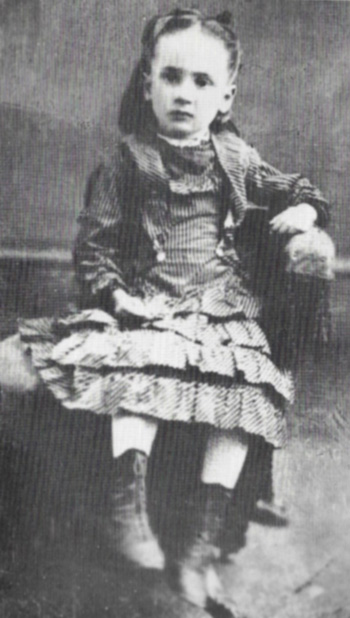 This
photo of Nellie Mooney was taken the day before her family left Ontario
for their new home in Manitoba.
It started when their son Will told the family about a book he read called “The Great Lone Land” which told tales of the adventure and the beauty to be found in the west. The family also saw newspaper stories that spoke of the wide open spaces out west. A visitor who had been to the west told of, “wild strawberries … so thick that they stained the feet of the oxen red.” It sounded great. The Mooneys were a large family and only had a small farm. There was no future where they lived. Nellie remembers her mom saying, “We have to go somewhere, John. There’s nothing here for our three boys. What can we do with one hundred and fifty stony acres? The boys will be hired men all their lives, or clerks in a store.” Will knew people who had been west and talked of, “a plain a hundred miles wide, and not a tree or stone in sight.” Stones and trees had made establishing these Ontario farms quite an effort. The bald prairie would be easy to plow. Of course they also wondered if it was all too good to be true. John wondered about the cold, about whether apple trees would grow, about mosquitoes and stories about the Aboriginal people who lived there. Would it be dangerous? Would they miss the comforts of their home? They decided to give it a try. The Trip The Mooneys’ trip also followed a well-known pattern. The quickest, easiest way to Manitoba in 1880 was by boat across the Great Lakes to Duluth, by train to Winnipeg. From there settlers had the option of riverboat or ox-cart trail depending on their destination. Often there was a stay in Winnipeg while the husband or son scouted for a suitable homestead. Then on the trail there would often be a stop - perhaps at Portage for supplies. Almost all accounts mention both hospitality and hardship as swamps, creeks, mud roads and equipment failure and other mishaps made the trip interesting. |
Page 29: Mrs. Weightman Makes a Fresh Start
| Mrs.
Elizabeth Weightman, a widow from northern England, and her
children, arrived at their homestead in the spring of 1882 after a
fifty-six day journey from Edinburgh, Scotland. They crossed the ocean on a crowded ship, then took the train to Lake Huron, where they caught a steamboat to Duluth, and another train to Brandon. At Brandon they bought the usual homestead supplies: oxen, a wagon, a plow, a tin stove, a tent and two cows. They decided to search for land and headed south of Brandon with a few other newcomers. On the second day out, news reached the party about land recently opened for homesteading, so a delegation sped ahead on a horse-drawn wagon towards the Land Titles Office in Deloraine. The rest continued with the oxen and supplies. High creeks and wet ground slowed them down – on a particularly bad day they travelled just five kilometers. |
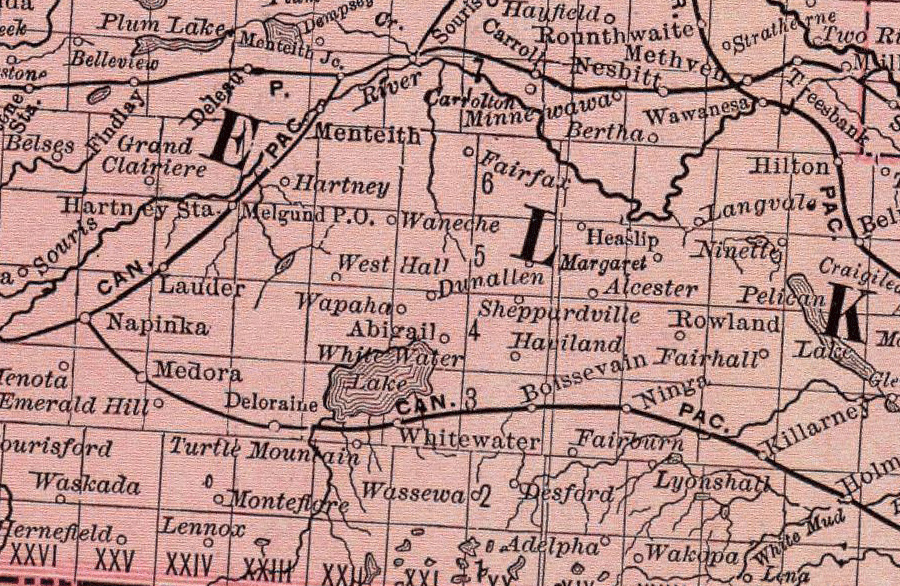
| The
reward came when the group returned from the Land Titles Office
with the papers entitling them each to a homestead. Two long days later
the Weightmans found their plot of land. They were home. As quickly as possible they broke some land and planted a few acres of oats and some potatoes. A sod barn was erected and a modest frame house was built – not quite finished for the coming of the first blizzard, but quite an improvement over the tents that had provided their only shelter up until this point. |
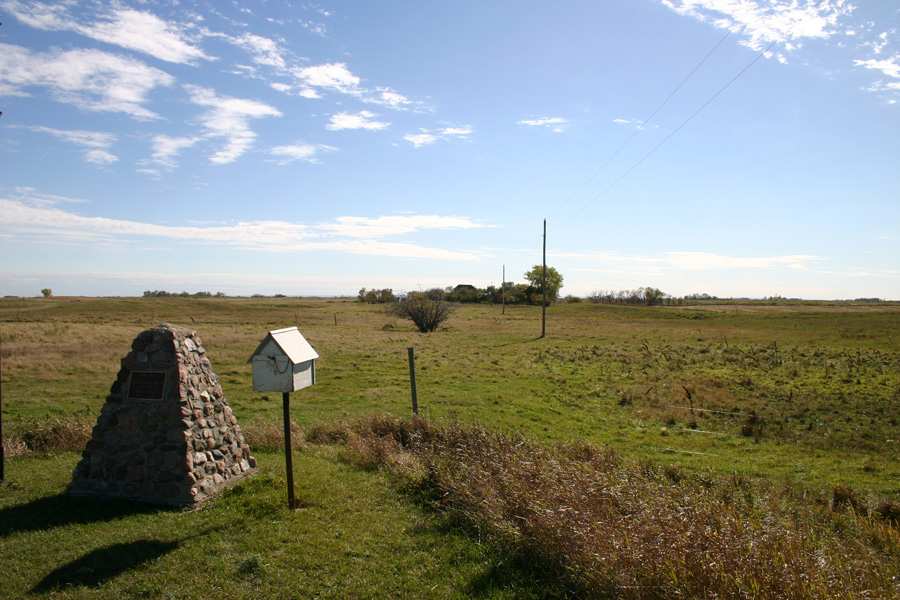
A school, also called West Hall was built on the Weightman property. Their original
farm yard is not occupied, but visible in the background.
Page 30: How to Build a “Soddy”.
| Most
of the first settlers started their homesteading life in a sod hut. Trees were scarce and wood was expensive. Getting that first crop planted was the priority. “Soddies” as they were called, provided quick shelter until a better house could be built. Here’s how to build one: Pick a little rise of land with good drainage to build your home. Find a bit of lower land, a soggy slough bottom perhaps, where the grass roots are thick and tough - that’s where to find the best sod. Use a plow to cut a smooth furrow 30 or 40 cm wide, then cut the sod into 50 cm lengths. Start by laying two tiers of sod side by side, making sure the ends aren’t lined up. , Then lay a second course crossways, this hold it all wall together. 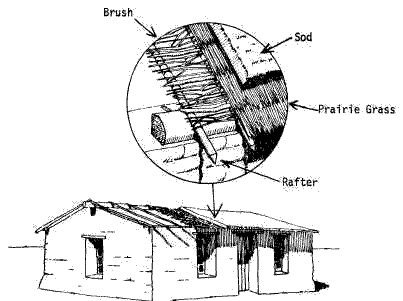 Try to include a few windows and a door by using planks as frames, when the wall reaches the proper height. One door is plenty and glass for windows might be hard to come by. The Roof Place strong poles down the centre of the building to support a ridge pole. Place rafters of poles from the ridge pole to the walls. Start with a layer of willow (hay could be used if necessary), then top with sod. If lumber is available, a wood floor is nice, if not, packed dirt will have to do for now. Interior walls can be smoothed and even coated with whitewash or plastered with clay. Heavy cotton can be stretched over ceilings and wall to give it that cozy, finished look. |
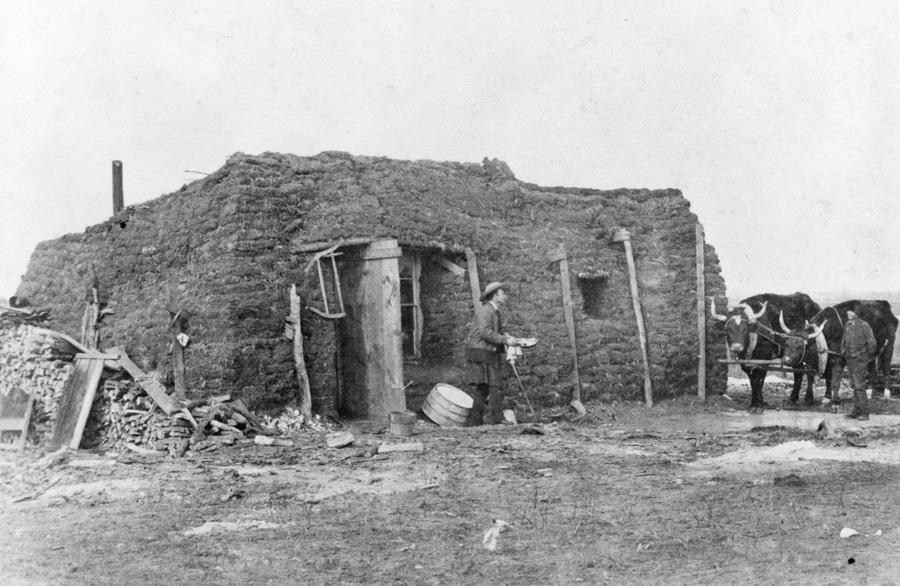
The finished product
Most people used their sod huts for just a few years before upgrading to wood.
Page 31: The Half-Way House
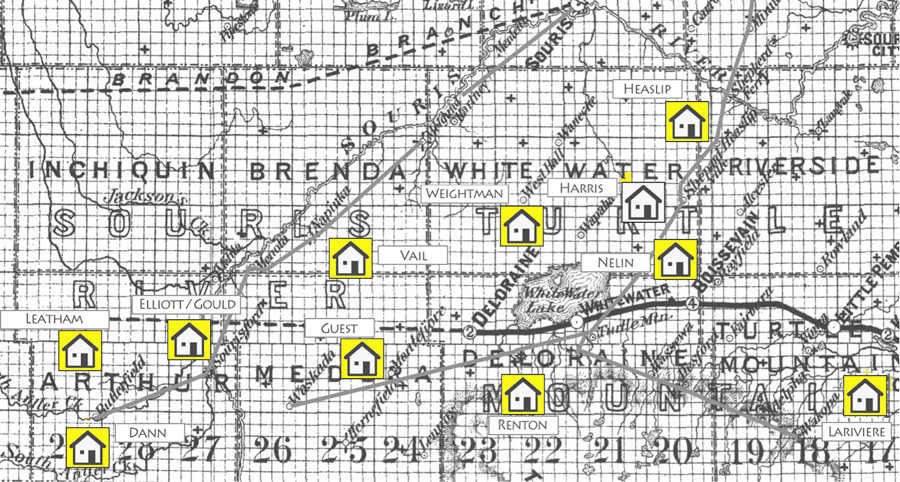
| Today a trip from Hartney to Brandon takes less than an hour. In 1882 it could take over a day. Travellers needed places to stop for the night. There were no towns and no hotels, so some settlers who happened to be on well-travelled trails would turn their home into a Stopping Place or Halfway House. Mrs. E. Weightman, near Dand must have noticed that she was about half way between Brandon and the busy Land Titles Office at Deloraine. It was a natural place for a Halfway House. Often regular travellers to Brandon would plan their trips around the location of the stopping houses. Even after decades had passed, an early resident of Deloraine remembered Mrs. Fox’s stopping house on the trail from Emerson to Boissevain as having especially good food. Reservations were not required and there was always a way to squeeze one more in – even if the hayloft had to be used. Halfway Houses were a combination; restaurant, motel, and livery stable. It was like a bed and breakfast with an extra meal thrown in – plus a gas station to fuel up your horse! The first stopping place known to operate in southwestern Manitoba was at “Old Wakopa” where Bernard LaRiviere had set up shop in an abandoned Boundary Commission building. The shack erected by Elliott and Gould, the first settlers at Sourisford (further west along that Boundary Commission Trail), was soon recognized as a stopping place, as was the home of William Walker in the Lyleton district. The John Renton home, within a mile of the Land Titles Office, was a natural place for a stopping place. It was also a natural place to hold church services – guests arriving on a Saturday night would likely have appreciated that. The earliest stopping houses also acted as informal postal outlets until a proper post office could be applied for and established. They had everything the traveller needed. |
Page 32: The Mailman
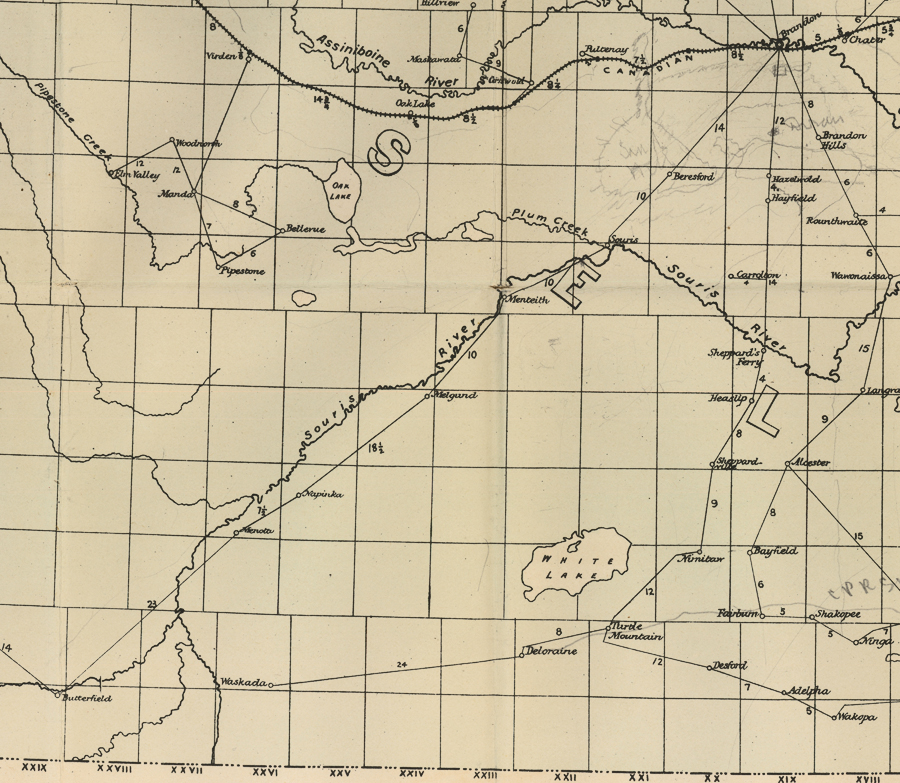
| In
the early 1880’s the main road from Old Deloraine to Brandon was the
Heaslip Trail named for Sam Heaslip who established the trail and used
it to deliver the mail. Each week he picked up the mail in Brandon. His first stop after crossing the Souris River would be his own home, the site of a post office named after him. The home also served as a stopping house and store. Sheppardvillle owned by Robert Sheppard was the next stop. From there it was on to Nimitaw where Mr. James Rae was Postmaster. Turtle Mountain, the main settlement in what would become the RM of Morton would be the next stop – a busy one at that. Heaslip’s route ended at Old Deloraine where mail for more distant spots was picked up by others. Some called the service a stagecoach, which probably meant Sam didn’t mind taking along a passenger or two. The other main mail route ran from Souris, along the Souris River to Butterfield, stopping at Melgund, Napinka, Menota on the way. Few of these stops were even the beginnings of villages – just farm homes that had a post office. |
Related Resources
| Home |
Contents | Downloads | Resources |